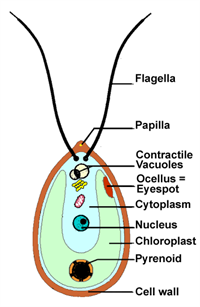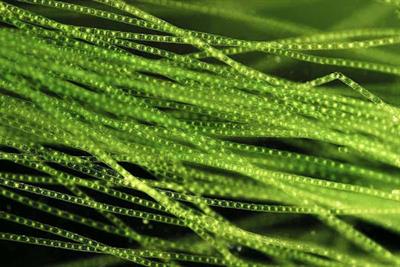
PUMPA - SMART LEARNING
எங்கள் ஆசிரியர்களுடன் 1-ஆன்-1 ஆலோசனை நேரத்தைப் பெறுங்கள். டாப்பர் ஆவதற்கு நாங்கள் பயிற்சி அளிப்போம்
Book Free DemoAlgae are the oldest plants on Earth. Algae belong to lower plants: they have no roots, no stems or leaves.
- Algae are autotrophs, having chloroplasts, they can manufacture their own food through photosynthesis.
- They reproduce by simple cell division or spores.
- Algae are unicellular or multicellular. Unicellular algae are in a variety of shapes such as rods, spherical, spindle, etc. Multicellular algae are ribbon-like filaments with or without branches.
Unicellular algae
Chlamydomonas a single-celled green coloured pear-shaped algae. It moves in water with the help of two flagella located at the front of its cell.
Externally, Chlamydomonas is covered with a transparent shell, under which are the following organelles:
- Cytoplasm with the nucleus,
- A red "eye" (light-sensitive red body),
- A large vacuole filled with cell sap,
- Two small pulsating vacuoles and
- The chlorophyll contained in the chromatophore.

- Chlamydomonas exhibit both sexual and asexual mode of reproduction.
- The chlorophyll gives a green colour to the whole cell.
Many algae have different colours based on the type of pigments they have which are shown in the table below:
| Colour of the algae | Pigment |
| red | phycoerythrin |
| brown | fucoxanthin |
| yellow | xanthophylls |
| blue | phycocyanin |
Chlorella is another unicellular green algae that are widespread in freshwater and wet soils.
Multicellular algae
In multicellular representatives of algae, the body of the algae has the form of threads or flat leaf-like formations.
Slippery bright green lumps often float or settle to the bottom in stagnant and slow-flowing waters. They look like cotton wool and formed accumulations of filamentous algae Spirogyra. Elongated cylindrical Spirogyra cells are covered with mucus. Inside the cells are chromatophores in the form of spirally twisted bands.
Slippery bright green lumps often float or settle to the bottom in stagnant and slow-flowing waters. They look like cotton wool and formed accumulations of filamentous algae Spirogyra. Elongated cylindrical Spirogyra cells are covered with mucus. Inside the cells are chromatophores in the form of spirally twisted bands.

Multicellular green algae also live in the waters of the seas and oceans. An example of such algae is the Ulva, or sea lettuce, about 30 cm long and only two cells thick.
Choral algae that live in freshwater bodies have the most complex structure in this group of plants. These numerous green algae look like horsetails. Choral alga Nitella, or flexible glitter, is often grown in aquariums.
Choral algae that live in freshwater bodies have the most complex structure in this group of plants. These numerous green algae look like horsetails. Choral alga Nitella, or flexible glitter, is often grown in aquariums.